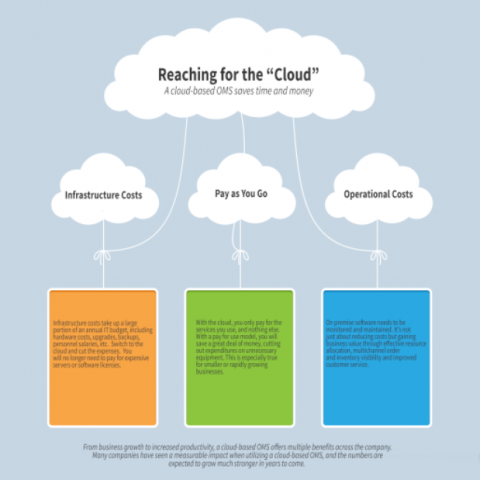
Migrating to the cloud is more than just a motto in today’s technology-driven world. Cloud based order management systems are quickly growing in popularity, as more than 78 percent of U.S. small businesses are expected to fully transition to cloud computing by 2020.
By adopting a cloud based order management system, you can significantly increase your business visibility to grow revenue, save money, fulfill orders faster, gain happier customers and more.
With a cloud based order management system, communication with your suppliers can dramatically evolve, which can ultimately improve customer service and lower inventory costs. When you consider switching from an on premise solution, or even a manual process, it is normal to be overwhelmed with the numerous cloud based systems out there.
Take a look below for some quick tips to look out for when choosing a cloud based order management system.
Look for Multichannel Visibility
The possibilities with a cloud based order management system are endless, as you gain the ability to view your inventory, orders and more in one place. One main reason SMB’s (small to medium-sized businesses) switch to the cloud is to gain visibility of orders and inventory across multiple sales channels.
If you’ve been using the order management features in your accounting or eCommerce system to manage multichannel sales, your visibility may be lacking. With a multichannel solution, you should be seeing an enhanced experience compared to your traditional system. You would be able to track orders, inventory levels, replenishment thresholds and top selling products, all while determining which sales channels are the best sellers.

Consider the Costs
Another reason to consider a cloud based solution is affordability throughout the purchasing process and beyond. A cloud based or SaaS (software-as-a-service) solution is generally priced on a subscription basis, where you pay per user per month, rather than incurring a large software purchase fee up front. It’s somewhat analogous to leasing a car vs. buying a car; i.e. paying monthly for use versus purchasing the system outright. SaaS solution updates are automatically made available to all customers using the solution. While on premise solutions can be beneficial, there are some things to keep in mind.
On premise solutions may require you to make the updates and, depending upon the level of enhancement, would require you to pay separately for them.
Pay Attention to Order Processing Times
Your cloud based solution should be extremely quick and non-disruptive. The main advantage to switching to the cloud is the seamless integration with all of your orders. With an automated order management system, data integration happens in real-time or near real-time, and offers seamless integration to other integrated applications, such as a QuickBooks Inventory Management Software solution.
Recognize the Technology Benefits for SMB’s
Technology is ever-expanding, and you do not want to be left to wrestle with countless updates a traditional system would require. A cloud based solution can effortlessly evolve with your supply-chain, no matter what size company you have. SMB’s can greatly benefit from cloud based solutions because of anytime, anywhere access, which allows you to keep track of inventory in one place. The only thing you need is an internet connection.
Keeping Track of Your Business with Visual Reporting
Your cloud based solution should offer you the ability to display reports with images, interactive data, etc., to give you multichannel visibility across sales channels and to keep you up-to-date on cross-channel orders and inventory. Real-time dashboards and reporting eliminates dated reporting. It’s important to keep in mind what is best for your particular business and future goals ahead.
But, now that you have a basic overview of what to look out for, find out exactly how a Cloud Based Order Management systems can save you time and money in the long-run below.





